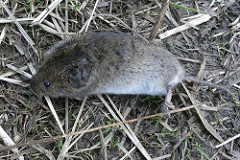Mole & Vole Pest Control Calgary

Moles typically dig tunnels that can destroy lawns and gardens. They can kill plants while they tunnel and remove soil around roots. The unprotected roots dry out and die. Plant diseases may also be spread by the moles. Pests like voles, field mice and other rodents use these tunnels as well to feed on exposed roots.
Signs of vole infestation are when the bark has been removed completely around the base of a tree, or the sight of 1 to 2 inch wide dead strips through matted grass leading to shallow underground burrows.
Voles called meadow mice, are more troublesome. They are herbivores, feeding on grasses, bulbs, tubers, and herbaceous plants. During the winter they may eat tree bark and roots, particularly on fruit trees. If the bark is gnawed around the entire circumference of the tree, the tree may be girdled and die. Voles are slightly larger than moles, reaching lengths of 5 to 8 inches at maturity. They also construct tunnels, or may use old mole tunnels. They produce characteristic surface runways between burrow openings, which are especially noticeable after snowmelt or after removing a layer of mulch. Voles, unlike moles or shrews, are more social and may be present in large numbers. Control voles by trapping with snap-type mousetraps baited with a peanut butter / oatmeal mixture, or with apple slices. A small garden will require at least a dozen traps. Continue setting traps in a particular area until no more voles are caught, then move the trap to a new location 15-20 feet away. Destroy old runways or tunnels to prevent new voles from moving right in. Poisons are not recommended since natural predators, dogs or cats may eat poisoned voles. Zinc phosphide baits are less troublesome in this respect. Place poisoned bait in the tunnels or runways every other day for at least three applications to ensure that the entire population has been dosed.

